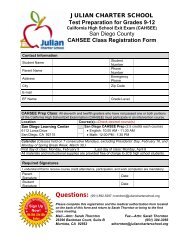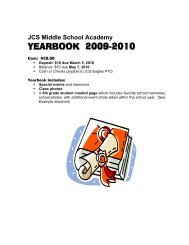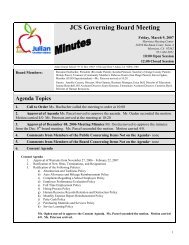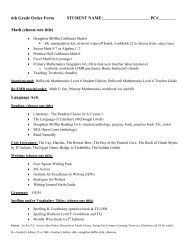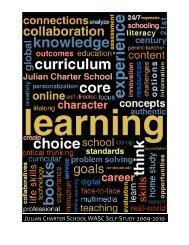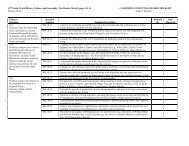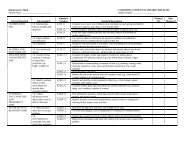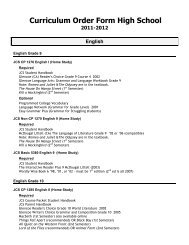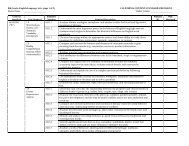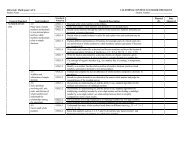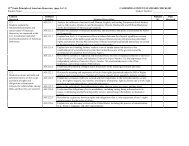11th Grade US History and Geography - Julian Charter School
11th Grade US History and Geography - Julian Charter School
11th Grade US History and Geography - Julian Charter School
You also want an ePaper? Increase the reach of your titles
YUMPU automatically turns print PDFs into web optimized ePapers that Google loves.
11 th <strong>Grade</strong> U.S. <strong>History</strong> <strong>and</strong> <strong>Geography</strong>: Continuity <strong>and</strong> Change in the Twentieth Century (page 1 of 5) CALIFORNIA CONTENT-STANDARD CHECKLIST<br />
Student Name: ___________________________<br />
Student Number: ____________________<br />
General<br />
St<strong>and</strong>ard<br />
St<strong>and</strong>ard<br />
Notation<br />
St<strong>and</strong>ard Description<br />
11.1<br />
<strong>US</strong>.11.1.1 Describe the Enlightenment <strong>and</strong> the rise of democratic ideas as the context in which the nation was<br />
Students analyze the<br />
founded.<br />
significant events in the <strong>US</strong>.11.1.2 Analyze the ideological origins of the American Revolution, the Founding Fathers’ philosophy of<br />
founding of the nation <strong>and</strong><br />
divinely bestowed unalienable natural rights, the debates on the drafting <strong>and</strong> ratification of the<br />
its attempts to realize the<br />
Constitution, <strong>and</strong> the addition of the Bill of Rights.<br />
philosophy of government <strong>US</strong>.11.1.3 Underst<strong>and</strong> the history of the Constitution after 1787 with emphasis on federal versus state authority<br />
described in the Declaration<br />
<strong>and</strong> growing democratization.<br />
of Independence. <strong>US</strong>.11.1.4 Examine the effects of the Civil War <strong>and</strong> Reconstruction <strong>and</strong> of the industrial revolution, including<br />
demographic shifts <strong>and</strong> the emergence in the late nineteenth century of the <strong>US</strong> as a world power.<br />
11.2<br />
<strong>US</strong>.11.2.1 Know the effects of industrialization on living <strong>and</strong> working conditions, including the portrayal of<br />
Students analyze the<br />
working conditions <strong>and</strong> food safety in Upton Sinclair’s The Jungle.<br />
relationship among the rise <strong>US</strong>.11.2.2 Describe the changing l<strong>and</strong>scape, including the growth of cities linked by industry <strong>and</strong> trade, <strong>and</strong> the<br />
of industrialization, largescale<br />
development of cities divided according to race, ethnicity, <strong>and</strong> class.<br />
rural-to-urban <strong>US</strong>.11.2.3 Trace the effect of the Americanization movement.<br />
migration, <strong>and</strong> massive <strong>US</strong>.11.2.4 Analyze the effect of urban political machines &responses to them by immigrants &middle-class<br />
immigration from Southern<br />
reformers<br />
<strong>and</strong> Eastern Europe. <strong>US</strong>.11.2.5 Discuss corporate mergers that produced trusts <strong>and</strong> cartels <strong>and</strong> the economic <strong>and</strong> political policies of<br />
industrial leaders.<br />
<strong>US</strong>.11.2.6 Trace the economic development of the United States <strong>and</strong> its emergence as a major industrial power,<br />
including its gains from trade <strong>and</strong> the advantages of its physical geography.<br />
<strong>US</strong>.11.2.7 Analyze the similarities <strong>and</strong> differences between the ideologies of Social Darwinism <strong>and</strong> Social<br />
Gospel (e.g., using biographies of William Graham Sumner, Billy Sunday, Dwight L. Moody).<br />
<strong>US</strong>.11.2.8 Examine the effect of political programs <strong>and</strong> activities of Populists.<br />
<strong>US</strong>.11.2.9 Underst<strong>and</strong> the effect of political programs <strong>and</strong> activities of the Progressives (e.g., federal regulation<br />
of railroad transport, Children’s Bureau, 16th Amendment, Theodore Roosevelt, Hiram Johnson).<br />
<strong>US</strong>.11.3.1 Describe the contributions of various religious groups to American civic principles <strong>and</strong> social reform<br />
movements (e.g., civil <strong>and</strong> human rights, individual responsibility <strong>and</strong> the work ethic, antimonarchy<br />
<strong>and</strong> self-rule, worker protection, family-centered communities).<br />
11.3<br />
Students analyze the role<br />
religion played in the<br />
founding of America, its<br />
lasting moral, social, <strong>and</strong><br />
political impacts, <strong>and</strong> issues<br />
regarding religious<br />
liberty.<br />
<strong>US</strong>.11.3.2<br />
<strong>US</strong>.11.3.3<br />
<strong>US</strong>.11.3.4<br />
<strong>US</strong>.11.3.5<br />
Analyze the great religious revivals <strong>and</strong> the leaders involved in them, including the First Great<br />
Awakening, the Second Great Awakening, the Civil War revivals, the Social Gospel Movement, the<br />
rise of Christian liberal theology in the nineteenth century, the impact of the Second Vatican Council,<br />
<strong>and</strong> the rise of Christian fundamentalism in current times.<br />
Cite incidences of religious intolerance in the United States (e.g., persecution of Mormons, anti-<br />
Catholic sentiment, anti-Semitism).<br />
Discuss the exp<strong>and</strong>ing religious pluralism in the United States <strong>and</strong> California that resulted from<br />
large-scale immigration in the twentieth century.<br />
Describe the principles of religious liberty found in the Establishment <strong>and</strong> Free Exercise clauses of<br />
the First Amendment, including the debate on the issue of separation of church <strong>and</strong> state.<br />
Planned<br />
(X)<br />
Date<br />
Mastered
11 th <strong>Grade</strong> U.S. <strong>History</strong> <strong>and</strong> <strong>Geography</strong>: Continuity <strong>and</strong> Change in the Twentieth Century (page 2 of 5)<br />
Student Name: ___________________________<br />
CALIFORNIA CONTENT-STANDARD CHECKLIST<br />
Student Number: ____________________<br />
General<br />
St<strong>and</strong>ard<br />
11.4<br />
Students trace the rise of the<br />
United States to its role as a<br />
world power in the<br />
twentieth century.<br />
11.5<br />
Students analyze the major<br />
political, social, economic,<br />
technological, <strong>and</strong> cultural<br />
developments of the 1920s.<br />
11.6<br />
Students analyze the<br />
different explanations for<br />
the Great Depression <strong>and</strong><br />
how the New Deal<br />
fundamentally changed the<br />
role of the federal<br />
government.<br />
St<strong>and</strong>ard<br />
Notation<br />
<strong>US</strong>.11.4.1<br />
<strong>US</strong>.11.4.2<br />
<strong>US</strong>.11.4.3<br />
<strong>US</strong>.11.4.4<br />
<strong>US</strong>.11.4.5<br />
<strong>US</strong>.11.4.6<br />
<strong>US</strong>.11.5.1<br />
<strong>US</strong>.11.5.2<br />
<strong>US</strong>.11.5.3<br />
<strong>US</strong>.11.5.4<br />
<strong>US</strong>.11.5.5<br />
<strong>US</strong>.11.5.6<br />
<strong>US</strong>.11.5.7<br />
<strong>US</strong>.11.6.1<br />
<strong>US</strong>.11.6.2<br />
<strong>US</strong>.11.6.3<br />
<strong>US</strong>.11.6.4<br />
<strong>US</strong>.11.6.5<br />
St<strong>and</strong>ard Description<br />
List the purpose <strong>and</strong> the effects of the Open Door policy.<br />
Describe the Spanish-American War <strong>and</strong> U.S. expansion in the South Pacific.<br />
Discuss America’s role in the Panama Revolution <strong>and</strong> the building of the Panama Canal.<br />
Explain Theodore Roosevelt’s Big Stick diplomacy, William Taft’s Dollar Diplomacy, <strong>and</strong> Woodrow<br />
Wilson’s Moral Diplomacy, drawing on relevant speeches.<br />
Analyze the political, economic, <strong>and</strong> social ramifications of World War I on the home front.<br />
Trace the declining role of Great Britain <strong>and</strong> the exp<strong>and</strong>ing role of the United States in world affairs<br />
after World War II.<br />
Discuss the policies of Presidents Warren Harding, Calvin Coolidge, <strong>and</strong> Herbert Hoover.<br />
Analyze the international <strong>and</strong> domestic events, interests, <strong>and</strong> philosophies that prompted attacks on<br />
civil liberties, including the Palmer Raids, Marcus Garvey’s “back-to-Africa” movement, the Ku<br />
Klux Klan, <strong>and</strong> immigration quotas <strong>and</strong> the responses of organizations such as the American Civil<br />
Liberties Union, the National Association for the Advancement of Colored People, <strong>and</strong> the Anti-<br />
Defamation League to those attacks.<br />
Examine the passage of the Eighteenth Amendment to the Constitution <strong>and</strong> the Volstead Act<br />
(Prohibition).<br />
Analyze the passage of the Nineteenth Amendment <strong>and</strong> the changing role of women in society.<br />
Describe the Harlem Renaissance <strong>and</strong> new trends in literature, music, <strong>and</strong> art, with special attention<br />
to the work of writers (e.g., Zora Neale Hurston, Langston Hughes).<br />
Trace the growth <strong>and</strong> effects of radio <strong>and</strong> movies <strong>and</strong> their role in the worldwide diffusion of popular<br />
culture.<br />
Discuss the rise of mass production techniques, the growth of cities, the impact of new technologies<br />
(e.g., the automobile, electricity), <strong>and</strong> the resulting prosperity <strong>and</strong> effect on the American l<strong>and</strong>scape.<br />
Describe the monetary issues of the late nineteenth <strong>and</strong> early twentieth centuries that gave rise to the<br />
establishment of the Federal Reserve & the weaknesses in key sectors of the economy in the late 20s<br />
Underst<strong>and</strong> the explanations of the principal causes of the Great Depression <strong>and</strong> the steps taken by<br />
the Federal Reserve, Congress, <strong>and</strong> Presidents Herbert Hoover <strong>and</strong> Franklin Delano Roosevelt to<br />
combat the economic crisis.<br />
Discuss the human toll of the Depression, natural disasters, <strong>and</strong> unwise agricultural practices <strong>and</strong><br />
their effects on the depopulation of rural regions <strong>and</strong> on political movements of the left <strong>and</strong> right,<br />
with particular attention to the Dust Bowl refugees <strong>and</strong> their social & economic impacts in California.<br />
Analyze the effects of <strong>and</strong> the controversies arising from New Deal economic policies <strong>and</strong> the<br />
exp<strong>and</strong>ed role of the federal government in society <strong>and</strong> the economy since the 1930s (e.g., Works<br />
Progress Administration, Social Security, National Labor Relations Board, farm programs, regional<br />
development policies, <strong>and</strong> energy development projects such as the Tennessee Valley Authority,<br />
California Central Valley Project, <strong>and</strong> Bonneville Dam).<br />
Trace the advances <strong>and</strong> retreats of organized labor, from the creation of the American Federation of<br />
Labor <strong>and</strong> the Congress of Industrial Organizations to current issues of a postindustrial, multinational<br />
economy, including the United Farm Workers in California.<br />
Planned<br />
(X)<br />
Date<br />
Mastered
11 th <strong>Grade</strong> U.S. <strong>History</strong> <strong>and</strong> <strong>Geography</strong>: Continuity <strong>and</strong> Change in the Twentieth Century (page 3 of 5)<br />
Student Name: ___________________________<br />
CALIFORNIA CONTENT-STANDARD CHECKLIST<br />
Student Number: ____________________<br />
General<br />
St<strong>and</strong>ard<br />
11.7<br />
Students analyze America’s<br />
participation in World War<br />
II.<br />
11.8<br />
Students analyze the<br />
economic boom <strong>and</strong> social<br />
transformation of post–<br />
World War II America.<br />
St<strong>and</strong>ard<br />
Notation<br />
<strong>US</strong>.11.7.1<br />
<strong>US</strong>.11.7.2<br />
<strong>US</strong>.11.7.3<br />
<strong>US</strong>.11.7.4<br />
<strong>US</strong>.11.7.5<br />
<strong>US</strong>.11.7.6<br />
<strong>US</strong>.11.7.7<br />
<strong>US</strong>.11.7.8<br />
<strong>US</strong>.11.8.1<br />
<strong>US</strong>.11.8.2<br />
<strong>US</strong>.11.8.3<br />
<strong>US</strong>.11.8.4<br />
<strong>US</strong>.11.8.5<br />
<strong>US</strong>.11.8.6<br />
<strong>US</strong>.11.8.7<br />
<strong>US</strong>.11.8.8<br />
St<strong>and</strong>ard Description<br />
Examine the origins of American involvement in the war, with an emphasis on the events that<br />
precipitated the attack on Pearl Harbor.<br />
Explain U.S. <strong>and</strong> Allied wartime strategy, including the major battles of Midway, Norm<strong>and</strong>y, Iwo<br />
Jima, Okinawa, <strong>and</strong> the Battle of the Bulge.<br />
Identify the roles <strong>and</strong> sacrifices of individual American soldiers, as well as the unique contributions<br />
of the special fighting forces (e.g., the Tuskegee Airmen, the 442nd Regimental Combat team, the<br />
Navajo Code Talkers).<br />
Analyze Roosevelt’s foreign policy during World War II (e.g., Four Freedoms speech).<br />
Discuss the constitutional issues <strong>and</strong> impact of events on the U.S. home front, including the<br />
internment of Japanese Americans (e.g., Fred Korematsu v. United States of America) <strong>and</strong> the<br />
restrictions on German <strong>and</strong> Italian resident aliens; the response of the administration to Hitler’s<br />
atrocities against Jews <strong>and</strong> other groups; the roles of women in military production; <strong>and</strong> the roles <strong>and</strong><br />
growing political dem<strong>and</strong>s of African Americans.<br />
Describe major developments in aviation, weaponry, communication, <strong>and</strong> medicine <strong>and</strong> the war’s<br />
impact on the location of American industry <strong>and</strong> use of resources.<br />
Discuss the decision to drop atomic bombs <strong>and</strong> the consequences of the decision (Hiroshima <strong>and</strong><br />
Nagasaki).<br />
Analyze the effect of massive aid given to Western Europe under the Marshall Plan to rebuild itself<br />
after the war <strong>and</strong> the importance of a rebuilt Europe to the U.S. economy.<br />
Trace the growth of service sector, white collar, <strong>and</strong> professional sector jobs in business <strong>and</strong><br />
government.<br />
Describe the significance of Mexican immigration <strong>and</strong> its relationship to the agricultural economy,<br />
especially in California.<br />
Examine Truman’s labor policy <strong>and</strong> congressional reaction to it.<br />
Analyze new federal government spending on defense, welfare, interest on the national debt, <strong>and</strong><br />
federal <strong>and</strong> state spending on education, including the California Master Plan.<br />
Describe the increased powers of the presidency in response to the Great Depression, World War II,<br />
<strong>and</strong> the Cold War.<br />
Discuss the diverse environmental regions of North America, their relationship to local economies,<br />
<strong>and</strong> the origins <strong>and</strong> prospects of environmental problems in those regions.<br />
Describe the effects on society <strong>and</strong> the economy of technological developments since 1945, including<br />
the computer revolution, changes in communication, advances in medicine, <strong>and</strong> improvements in<br />
agricultural technology.<br />
Discuss forms of popular culture, with emphasis on their origins <strong>and</strong> geographic diffusion (e.g., jazz<br />
<strong>and</strong> other forms of popular music, professional sports, architectural <strong>and</strong> artistic styles).<br />
Planned<br />
(X)<br />
Date<br />
Mastered
11 th <strong>Grade</strong> U.S. <strong>History</strong> <strong>and</strong> <strong>Geography</strong>: Continuity <strong>and</strong> Change in the Twentieth Century (page 4 of 5) CALIFORNIA CONTENT-STANDARD CHECKLIST<br />
Student Name: ___________________________<br />
Student Number: ____________________<br />
General<br />
St<strong>and</strong>ard<br />
11.9<br />
Students analyze U.S.<br />
foreign policy since World<br />
War II.<br />
11.10<br />
Students analyze the<br />
development of federal civil<br />
rights <strong>and</strong> voting rights.<br />
St<strong>and</strong>ard<br />
Notation<br />
<strong>US</strong>.11.9.1<br />
<strong>US</strong>.11.9.2<br />
<strong>US</strong>.11.9.3<br />
<strong>US</strong>.11.9.4<br />
<strong>US</strong>.11.9.5<br />
<strong>US</strong>.11.9.6<br />
<strong>US</strong>.11.9.7<br />
<strong>US</strong>.11.10.1<br />
<strong>US</strong>.11.10.2<br />
<strong>US</strong>.11.10.3<br />
<strong>US</strong>.11.10.4<br />
St<strong>and</strong>ard Description<br />
Discuss the establishment of the United Nations <strong>and</strong> International Declaration of Human Rights,<br />
International Monetary Fund, World Bank, <strong>and</strong> General Agreement on Tariffs <strong>and</strong> Trade (GATT)<br />
<strong>and</strong> their importance in shaping modern Europe <strong>and</strong> maintaining peace <strong>and</strong> international order.<br />
Underst<strong>and</strong> the role of military alliances, including NATO <strong>and</strong> SEATO, in deterring communist<br />
aggression <strong>and</strong> maintaining security during the Cold War.<br />
Trace the origins <strong>and</strong> geopolitical consequences (foreign <strong>and</strong> domestic) of the Cold War <strong>and</strong><br />
containment policy, including the following:<br />
• The era of McCarthyism, instances of domestic Communism (e.g., Alger Hiss) & blacklisting<br />
• The Truman Doctrine<br />
• The Berlin Blockade<br />
• The Korean War<br />
• The Bay of Pigs invasion <strong>and</strong> the Cuban Missile Crisis<br />
• Atomic testing in the Amer. West, “mutual assured destruction” doctrine, &disarmament policies<br />
• The Vietnam War<br />
• Latin American policy<br />
List the effects of foreign policy on domestic policies <strong>and</strong> vice versa (e.g., protests during the war in<br />
Vietnam, the “nuclear freeze” movement).<br />
Analyze the role of the Reagan administration <strong>and</strong> other factors in the victory of the West in the Cold<br />
War.<br />
Describe U.S. Middle East policy <strong>and</strong> its strategic, political, <strong>and</strong> economic interests, including those<br />
related to the Gulf War.<br />
Examine relations between the United States <strong>and</strong> Mexico in the twentieth century, including key<br />
economic, political, immigration, <strong>and</strong> environmental issues.<br />
Explain how dem<strong>and</strong>s of African Americans helped produce a stimulus for civil rights, including<br />
President Roosevelt’s ban on racial discrimination in defense industries in 1941, <strong>and</strong> how African<br />
Americans’ service in World War II produced a stimu lus for President Truman’s decision to end<br />
segregation in the armed forces in 1948.<br />
Examine <strong>and</strong> analyze the key events, policies, <strong>and</strong> court cases in the evolution of civil rights,<br />
including Dred Scott v. S<strong>and</strong>ford, Plessy v. Ferguson, Brown v. Board of Education, Regents of the<br />
University of California v. Bakke, <strong>and</strong> California Proposition 209.<br />
Describe the collaboration on legal strategy between African American <strong>and</strong> white civil rights lawyers<br />
to end racial segregation in higher education.<br />
Examine the roles of civil rights advocates (e.g., A. Philip R<strong>and</strong>olph, Martin Luther King, Jr.,<br />
Malcom X, Thurgood Marshall, James Farmer, Rosa Parks), including the significance of Martin<br />
Luther King, Jr.’s “Letter from Birmingham Jail” <strong>and</strong> “I Have a Dream” speech.<br />
Planned<br />
(X)<br />
Date<br />
Mastered
11 th <strong>Grade</strong> U.S. <strong>History</strong> <strong>and</strong> <strong>Geography</strong>: Continuity <strong>and</strong> Change in the Twentieth Century (page 5 of 5) CALIFORNIA CONTENT-STANDARD CHECKLIST<br />
Student Name: ___________________________<br />
Student Number: ____________________<br />
General<br />
St<strong>and</strong>ard<br />
11.10<br />
Students analyze the<br />
development of federal civil<br />
rights <strong>and</strong> voting rights.<br />
(continued)<br />
11.11<br />
Students analyze the major<br />
social problems <strong>and</strong><br />
domestic policy issues in<br />
contemporary American<br />
society.<br />
St<strong>and</strong>ard<br />
Notation<br />
<strong>US</strong>.11.10.5<br />
<strong>US</strong>.11.10.6<br />
<strong>US</strong>.11.10.7<br />
<strong>US</strong>.11.11.1<br />
<strong>US</strong>.11.11.2<br />
<strong>US</strong>.11.11.3<br />
<strong>US</strong>.11.11.4<br />
<strong>US</strong>.11.11.5<br />
<strong>US</strong>.11.11.6<br />
<strong>US</strong>.11.11.7<br />
St<strong>and</strong>ard Description<br />
Discuss the diffusion of the civil rights movement of African Americans from the churches of the<br />
rural South <strong>and</strong> the urban North, including the resistance to racial desegregation in Little Rock <strong>and</strong><br />
Birmingham, <strong>and</strong> how the advances influenced the agendas, strategies, <strong>and</strong> effectiveness of the quests<br />
of American Indians, Asian Americans, <strong>and</strong> Hispanic Americans for civil rights <strong>and</strong> equal<br />
opportunities.<br />
Analyze the passage <strong>and</strong> effects of civil rights <strong>and</strong> voting rights legislation (e.g., 1964 Civil Rights<br />
Act, Voting Rights Act of 1965) <strong>and</strong> the Twenty-Fourth Amendment, with an emphasis on equality<br />
of access to education <strong>and</strong> to the political process.<br />
Analyze the women’s rights movement from the era of Elizabeth Stanton <strong>and</strong> Susan Anthony <strong>and</strong> the<br />
passage of the Nineteenth Amendment to the movement launched in the 1960s, including differing<br />
perspectives on the roles of women.<br />
Discuss the reasons for the nation’s changing immigration policy, with emphasis on how the<br />
Immigration Act of 1965 <strong>and</strong> successor acts have transformed American society.<br />
Discuss the significant domestic policy speeches of Truman, Eisenhower, Kennedy, Johnson, Nixon,<br />
Carter, Reagan, Bush, <strong>and</strong> Clinton (e.g., with regard to education, civil rights, economic policy,<br />
environmental policy).<br />
Describe the changing roles of women in society as reflected in the entry of more women into the<br />
labor force <strong>and</strong> the changing family structure.<br />
Explain the constitutional crisis originating from the Watergate sc<strong>and</strong>al.<br />
Trace the impact of, need for, <strong>and</strong> controversies associated with environmental conservation,<br />
expansion of the national park system, <strong>and</strong> the development of environmental<br />
protection laws, with particular attention to the interaction between environmental protection<br />
advocates <strong>and</strong> property rights advocates.<br />
Analyze the persistence of poverty <strong>and</strong> how different analyses of this issue influence welfare reform,<br />
health insurance reform, <strong>and</strong> other social policies.<br />
Explain how the federal, state, <strong>and</strong> local governments have responded to demo -graphic <strong>and</strong> social<br />
changes such as population shifts to the suburbs, racial concentrations in the cities, Frostbelt-to-<br />
Sunbelt migration, international migration, decline of family farms, increases in out-of-wedlock<br />
births, <strong>and</strong> drug abuse.<br />
Planned<br />
(X)<br />
Date<br />
Mastered



